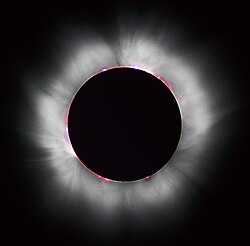恒星大气层
恒星大气层是恒星的最外层区域,位置在核心、辐射层和对流层之上,依照独特的特征可以分为数层:
- 光球层是大气层的最底层,也是我们能观察到的大气层中温度最低的一层[1]。来自恒星的光经由这一层从穿越更高的数层后,由恒星的表面逃逸入太空。太阳的光球层温度为5700K到5,780 K范围[2][3],星斑是光球层上受到磁场扰乱而温度较低的区域[3]。

- 在光球层之上的是色球层,这一层开始时的温度会下降,然后随着高度上升逐渐增温至光球层的10倍左右。
- 在这之上就是恒星大气层的外围部分,是由非常稀薄但极端高温(百万K)的等离子构成的星冕[5],过渡区和星冕是在主序带上所有的恒星都有的外观。但不是所有演化中的恒星都是如此,看起来只有一些巨星和极少数的超巨星才有星冕。在天体物理学中尚待待解决的问题是星冕是如何被加热到如此高的温度?答案可能在恒星的磁场上,但确切的机制依然还没有被清楚了解[6]。
以太阳为例,当日全食之际,太阳的光球层被遮蔽时,大气层中的其他层次便被显露出来[1]。在这种情况下,色球层呈现出略带粉红色的圆弧[7],而日冕(太阳的星冕)像装了一簇缨球的光晕。在食双星同样的现象可以让巨星的色球层可见[8]。
参阅
编辑- 塞西莉亚·佩恩-加波施金 - 首先提出了当前接受的恒星大气层组成的天文学家。
参考资料
编辑- ^ 1.0 1.1 "Beyond the Blue Horizon" – A Total Solar Eclipse Chase. 1999-08-05 [2010-05-21]. (原始内容存档于2012-02-10).
On ordinary days, the corona is hidden by the blue sky, since it is about a million times fainter than the layer of the sun we see shining every day, the photosphere.
- ^ Mariska, J.T. The solar transition region. Cambridge Astrophysics Series. Cambridge University Press. [2017-06-18]. ISBN 978-0-521-38261-8. (原始内容存档于2016-03-30).
- ^ 3.0 3.1 Lang, K.R. 5.1 MAGNETIC FIELDS IN THE VISIBLE PHOTOSPHERE. Sun, earth, and sky 2nd. Springer. September 2006: 81. ISBN 978-0-387-30456-4.
this opaque layer is the photosphere, the level of the Sun from which we get our light and heat
- ^ Mariska, J.T. The solar transition region. : 60. ISBN 978-0-521-38261-8.
100 km suggested by average models
- ^ R.C. Altrock. The Temperature of the Low Corona During Solar Cycles 21–23. Solar Physics. 2004, 224: 255. Bibcode:2004SoPh..224..255A. doi:10.1007/s11207-005-6502-4.
- ^ The Sun's Corona – Introduction. NASA. [2010-05-21]. (原始内容存档于2012-02-10).
Now most scientists believe that the heating of the corona is linked to the interaction of the magnetic field lines.
- ^ Lewis, J.S. Physics and chemistry of the solar system Second. Elsevier Academic Press. 2004-02-23: 87. ISBN 978-0-12-446744-6.
The dominant color is influenced by the Balmer radiation of atomic hydrogen
- ^ Griffin, R. Elizabeth. Only Binary Stars Can Help Us Actually SEE a Stellar Chromosphere. Proceedings of the International Astronomical Union. 2006-08, 2 (S240): 700–705. ISSN 1743-9213. doi:10.1017/S1743921307006163 (英语).